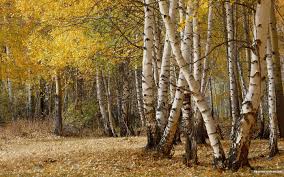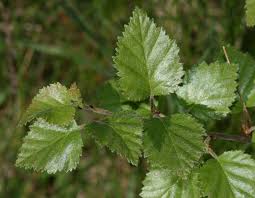|
Birch Wood Silver Birch leaves Downy Birch leaves Of withered trunk fair haired the birch. Faded trunk and fair hair. Browed beauty worthy of pursuit. Most silver of skin. Book of Ballymote 1391 Birch Fact File Betula pendula, Silver Birch Betula pubescens, Downy Birch. Betula nana, Dwarf birch Mature birchwood is often a light airy place supporting a myriad of many types of fungi (beech wood is also beneficial for fungus). It casts little shade and one can often observe redpolls and tits flitting and feeding amongst the canopy. These birds will use the seed as a food source. The leaves are a food source for the mottled umber caterpillar moth. There are two classes of flora: 1. Blaeberry (Vaccinium mrytillus) rich birchwoods. 2. Herb-rich birchwoods with a grassy floor. Birch often grows on acid soils ( with a preference for lighter soils) and interestingly birch actually deacidifies the soil as not only are its leaves rich in nitrogen, thereby enriching the soil, but also in calcium therefore carrying out the former process. Birch will grow amongst other woodland types in clearings as it is an effective coloniser. It will also grow on the edges of woods wherever an opportunity arises. Its role in ancient natural history is as a first coloniser giving way to other species of tree in the process known as natural succession where the final species to dominate a given site is known as the Climax Species. However birch wood can be surprisingly persistent and is the natural climax species in the highlands of Scotland. Pollen from Loch Maree confirms continuous birch regeneration for the past 9,000 years! Further south in England we have a wood called ‘Birkland’ in Sherwood forest which name implies the Vikings recognised it as a birch wood over a thousand years ago. There are two main species of birch in Britain and a third species specialist to the Scottish Highlands. 1/ Betula pendula, Silver Birch 2/ Betula pubescens, Downy Birch. 3 / Betula nana, Dwarf birch (specialist species of the Scottish Highlands). The main two birches were formally recognised and published in 1791. The Downy Birch is more associated with ancient woodlands, has stiffer twigs which do not droop (better for brooms) and leaves which have less ragged teeth and are hairy on the underside with a triangular base. The Silver Birch is more associated with wood pasture and is more useful for timber due to a more cylindrical trunk. Its branches droop and its leaves have a straight base and are not hairy. In Scotland and in other parts of Britain birch has many uses. Commercially it was used for reels and bobbins as well as the commonest fuel used for the ironworks in the weald. Locally its bark was used for roofing and making shampoo. Birch is the tree of new beginnings representing the qualities of inception. She has a dynamic, gentle, yet strong energy to help build and visualise a new way of being, the start of your journey into the inner worlds or the decision to commit more fully to your self-development. Birch is associated with births, initiations, the spring and love. The deities that work with those qualities through birch are in Wales Arianrhodd and Gwyndion; Diarmid and Grainnah in Ireland; Frigga in Norway and the Anglo-Saxon Goddesses of Spring Eostre. The Ogham name Beithe means being or a being and the Birch Grove is a place to connect with other-wordly visitors. This connection is further enhanced as it is said to be the first Ogham inscription that was written to warn Lugh Lamfada that his wife was being taken to faerie land. Herbal remedies. Birch sap collected in March can be used for kidney/bladder stones and rheumatic diseases as well as for a cleansing mouthwash and is excellent for the skin. Birch bark can be used as a diuretic, antiseptic and anaesthetic enabling nerve endings to lose sensations and relieve muscle pain. Poetry of Birch. Ancient tundra birch-dominated, Solitude of creation, giving birth. Naturally regenerates over thousands of years, In the coldest of places, gentle strength perseveres. Silver her bark, black are her branches, A spring Goddess as she advances. Famine power, persistent strength Like Spring unfolding without relent. O Birch, you teach us to be gentle when we fall, May our hearts remain open and kind to all. Learn more by subscribing to our newsletter Here.
0 Comments
Leave a Reply. |
Details
Poetry of flowersJoin me to explore the flora of the British Isles on this blog. My intention is to attempt to capture the unique quality and beauty of each species of flower, tree or shrub. For every species featured I will be growing many more wildflowers to celebrate the joy of their existence, their intrinsic conservation value and bewildering array of uses. For nearly 30 years I have noted, studied and explored wildflowers in the field much to the patience of the walker beside me. To share this passion is a heartfelt plea to respect, preserve and care for all British Wildflowers no matter how common they seem. Archives
February 2024
Categories |




 RSS Feed
RSS Feed
